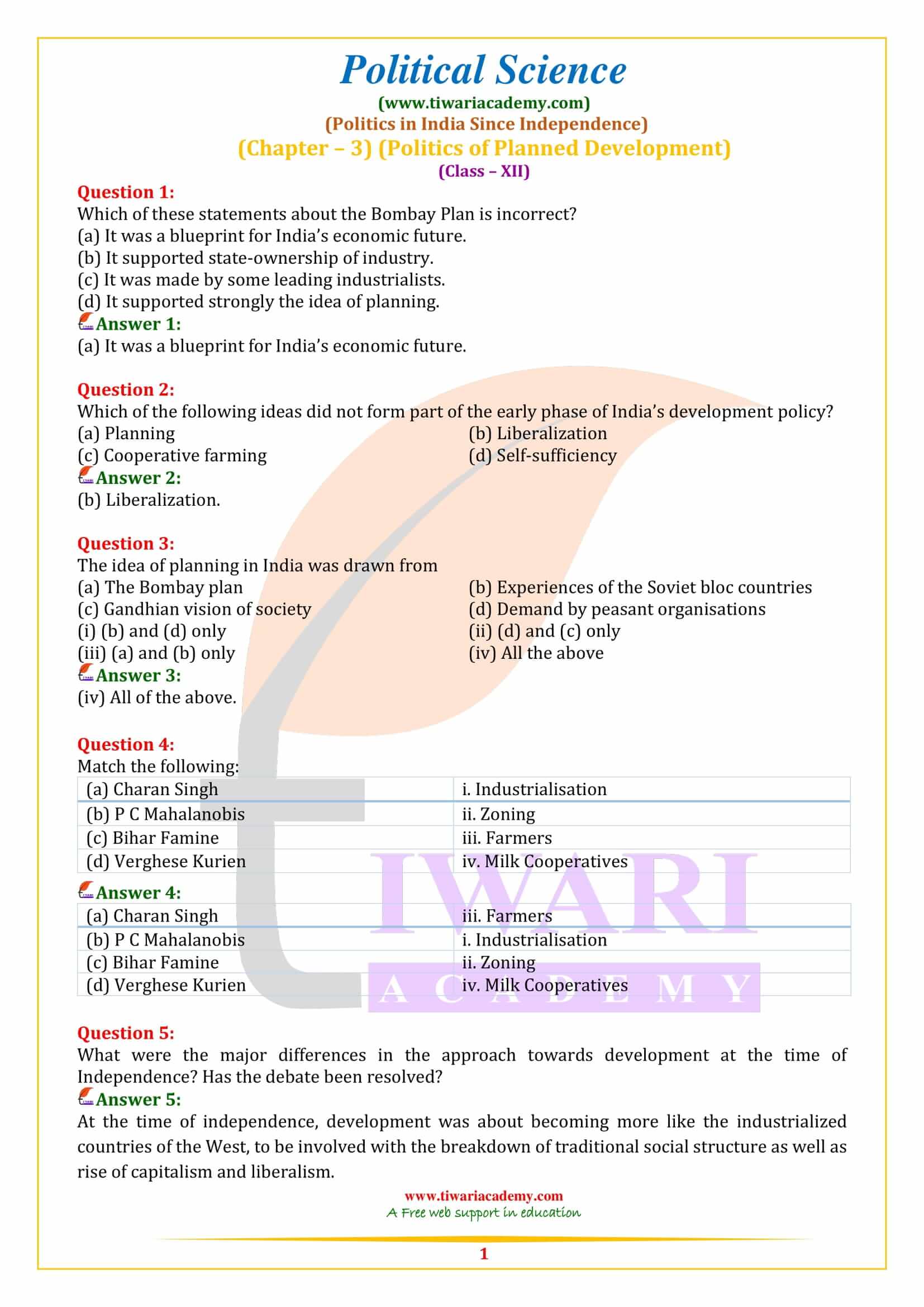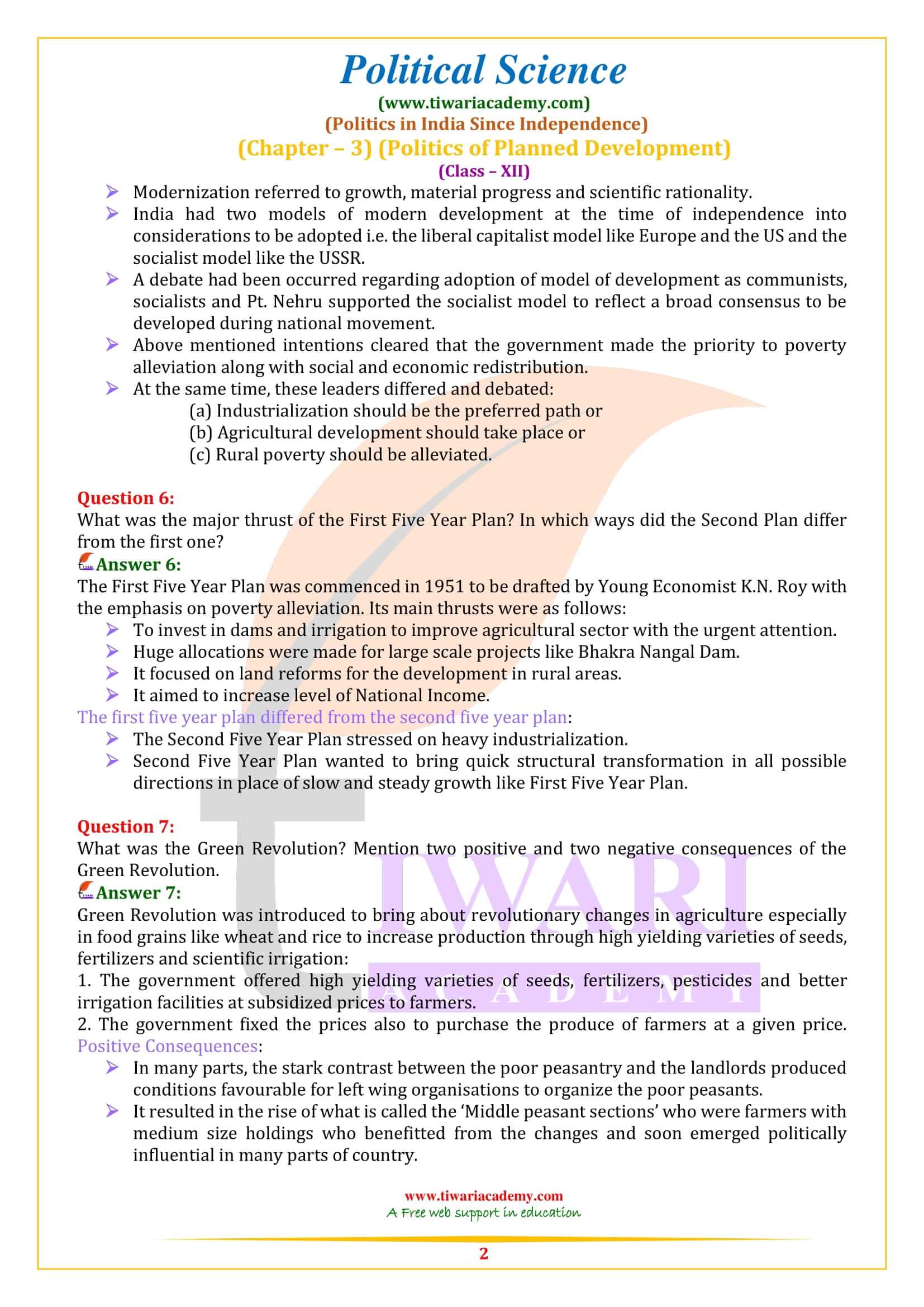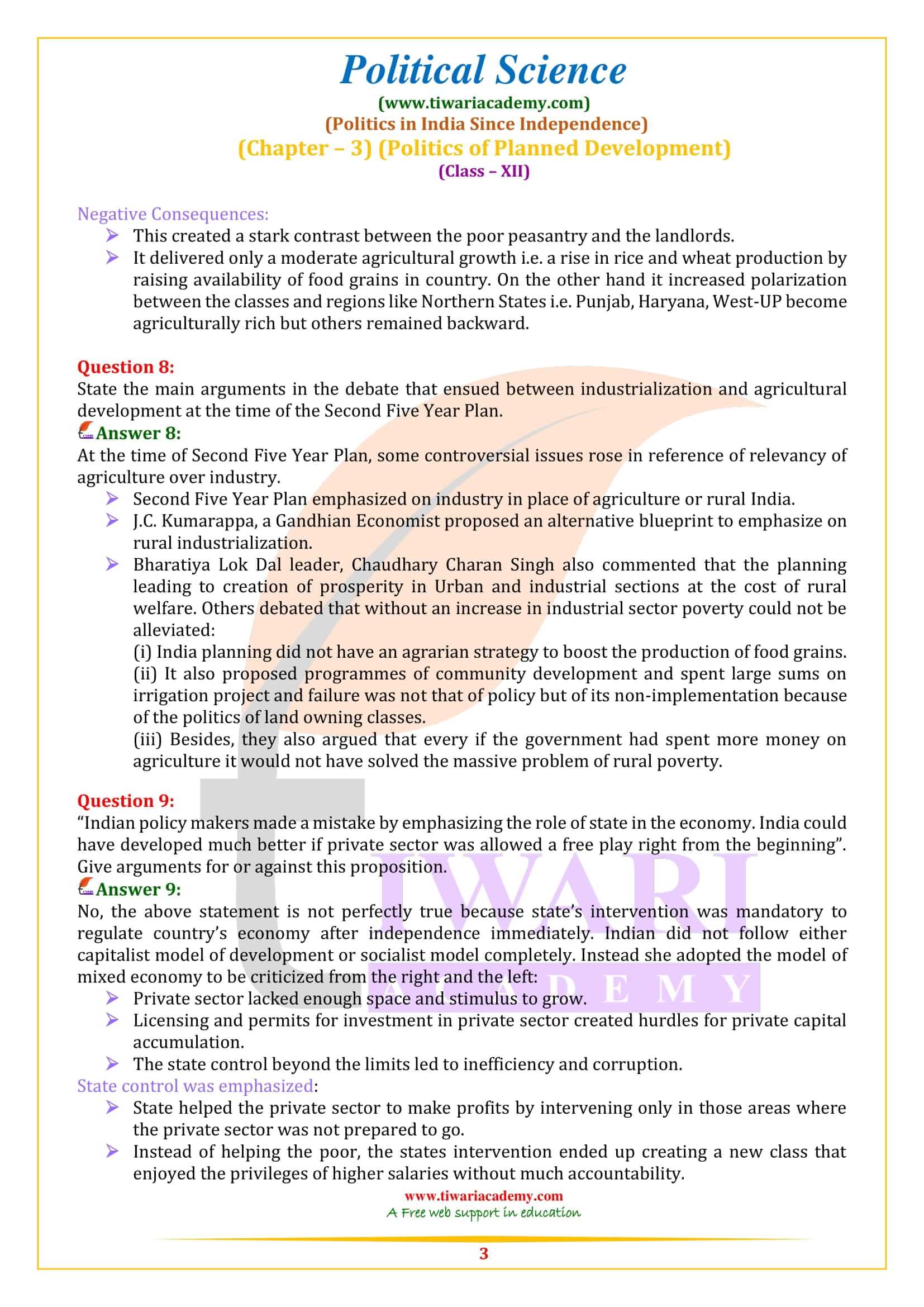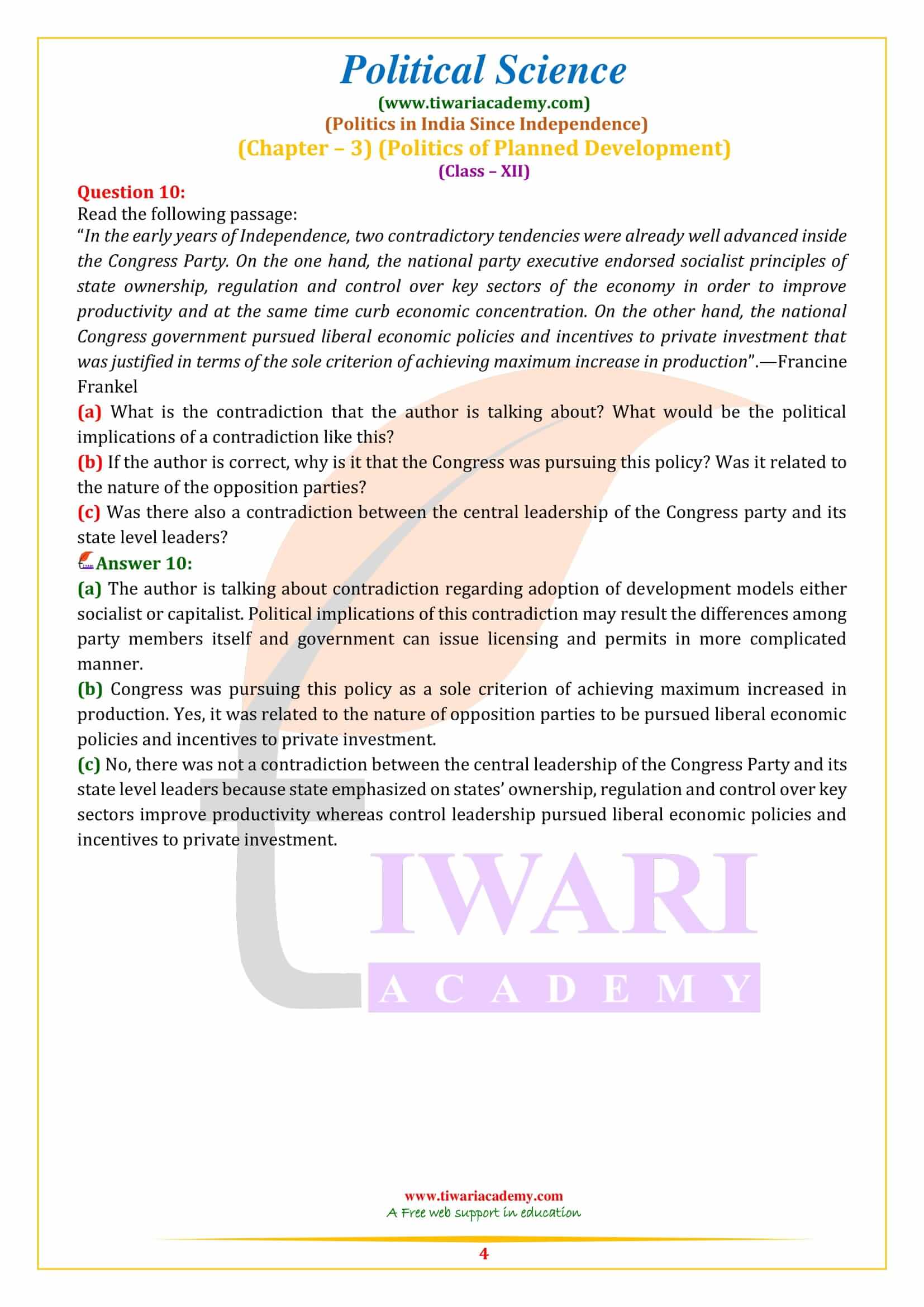NCERT Solutions for Class 12 Political Science Part 2 Chapter 3 Politics of Planned Development in Hindi and English Medium for new session CBSE and State board. Question-answers of Class 12 Political Science Part 2 Politics in India since Independence chapter 3 are based on new NCERT Books for 2025-26. Solutions are available in Hindi and English language.
NCERT Solutions for Class 12 Political Science Chapter 3
Class 12 Political Science Chapter 3 Politics of Planned Development
Class 12 Political Science Chapter 3 MCQ
Which of these statements about the Bombay Plan is incorrect?
Which of the following ideas did not form part of the early phase of India’s development policy?
What were the major differences in the approach towards development at the time of Independence? Has the debate been resolved?
At the time of independence, development was about becoming more like the industrialized countries of the West, to be involved with the breakdown of traditional social structure as well as rise of capitalism and liberalism.
- Modernization referred to growth, material progress and scientific rationality.
- India had two models of modern development at the time of independence into considerations to be adopted i.e. the liberal capitalist model like Europe and the US and the socialist model like the USSR.
- A debate had been occurred regarding adoption of model of development as communists, socialists and Pt. Nehru supported the socialist model to reflect a broad consensus to be developed during national movement.
- Above mentioned intentions cleared that the government made the priority to poverty alleviation along with social and economic redistribution.
- At the same time, these leaders differed and debated:
(a) Industrialization should be the preferred path or
(b) Agricultural development should take place or
(c) Rural poverty should be alleviated.
What was the major thrust of the First Five Year Plan? In which ways did the Second Plan differ from the first one?
The First Five Year Plan was commenced in 1951 to be drafted by Young Economist K.N. Roy with the emphasis on poverty alleviation. Its main thrusts were as follows:
- To invest in dams and irrigation to improve agricultural sector with the urgent attention.
- Huge allocations were made for large scale projects like Bhakra Nangal Dam.
- It focused on land reforms for the development in rural areas.
- It aimed to increase level of National Income.
The first five year plan differed from the second five year plan:
- The Second Five Year Plan stressed on heavy industrialization.
- Second Five Year Plan wanted to bring quick structural transformation in all possible directions in place of slow and steady growth like First Five Year Plan.
What was the Green Revolution? Mention two positive and two negative consequences of the Green Revolution.
Green Revolution was introduced to bring about revolutionary changes in agriculture especially in food grains like wheat and rice to increase production through high yielding varieties of seeds, fertilizers and scientific irrigation:
1. The government offered high yielding varieties of seeds, fertilizers, pesticides and better irrigation facilities at subsidized prices to farmers.
2. The government fixed the prices also to purchase the produce of farmers at a given price.
Positive Consequences:
- In many parts, the stark contrast between the poor peasantry and the landlords produced conditions favourable for left wing organisations to organize the poor peasants.
- It resulted in the rise of what is called the ‘Middle peasant sections’ who were farmers with medium size holdings who benefitted from the changes and soon emerged politically influential in many parts of country.
Negative Consequences:
- This created a stark contrast between the poor peasantry and the landlords.
- It delivered only a moderate agricultural growth i.e. a rise in rice and wheat production by raising availability of food grains in country. On the other hand it increased polarization between the classes and regions like Northern States i.e. Punjab, Haryana, West-UP become agriculturally rich but others remained backward.
State the main arguments in the debate that ensued between industrialization and agricultural development at the time of the Second Five Year Plan.
At the time of Second Five Year Plan, some controversial issues rose in reference of relevancy of agriculture over industry.
1. Second Five Year Plan emphasized on industry in place of agriculture or rural India.
2. J.C. Kumarappa, a Gandhian Economist proposed an alternative blueprint to emphasize on rural industrialization.
3. Bharatiya Lok Dal leader, Chaudhary Charan Singh also commented that the planning leading to creation of prosperity in Urban and industrial sections at the cost of rural welfare. Others debated that without an increase in industrial sector poverty could not be alleviated:
- (i) India planning did not have an agrarian strategy to boost the production of food grains.
- (ii) It also proposed programmes of community development and spent large sums on irrigation project and failure was not that of policy but of its non-implementation because of the politics of land owning classes.
- (iii) Besides, they also argued that every if the government had spent more money on agriculture it would not have solved the massive problem of rural poverty.
Indian policy makers made a mistake by emphasizing the role of state in the economy. India could have developed much better if private sector was allowed a free play right from the beginning. Give arguments for or against this proposition.
No, the above statement is not perfectly true because state’s intervention was mandatory to regulate country’s economy after independence immediately. Indian did not follow either capitalist model of development or socialist model completely. Instead she adopted the model of mixed economy to be criticized from the right and the left:
- Private sector lacked enough space and stimulus to grow.
- Licensing and permits for investment in private sector created hurdles for private capital accumulation.
- The state control beyond the limits led to inefficiency and corruption.
State control was emphasized:
- State helped the private sector to make profits by intervening only in those areas where the private sector was not prepared to go.
- Instead of helping the poor, the states intervention ended up creating a new class that enjoyed the privileges of higher salaries without much accountability.
Read the following passage:
“In the early years of Independence, two contradictory tendencies were already well advanced inside the Congress Party. On the one hand, the national party executive endorsed socialist principles of state ownership, regulation and control over key sectors of the economy in order to improve productivity and at the same time curb economic concentration. On the other hand, the national Congress government pursued liberal economic policies and incentives to private investment that was justified in terms of the sole criterion of achieving maximum increase in production”.—Francine Frankel
What is the contradiction that the author is talking about? What would be the political implications of a contradiction like this?
The author is talking about contradiction regarding adoption of development models either socialist or capitalist. Political implications of this contradiction may result the differences among party members itself and government can issue licensing and permits in more complicated manner.
If the author is correct, why is it that the Congress was pursuing this policy? Was it related to the nature of the opposition parties?
Congress was pursuing this policy as a sole criterion of achieving maximum increased in production. Yes, it was related to the nature of opposition parties to be pursued liberal economic policies and incentives to private investment.
Was there also a contradiction between the central leadership of the Congress party and its state level leaders?
No, there was not a contradiction between the central leadership of the Congress Party and its state level leaders because state emphasized on states’ ownership, regulation and control over key sectors improve productivity whereas control leadership pursued liberal economic policies and incentives to private investment.





